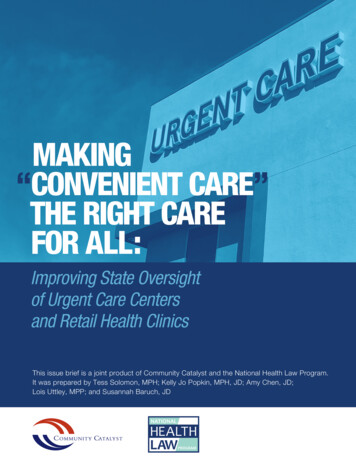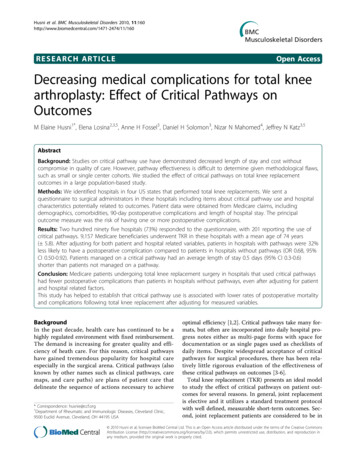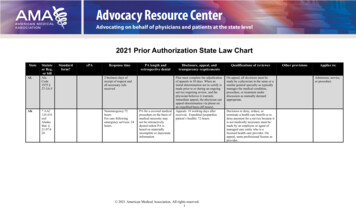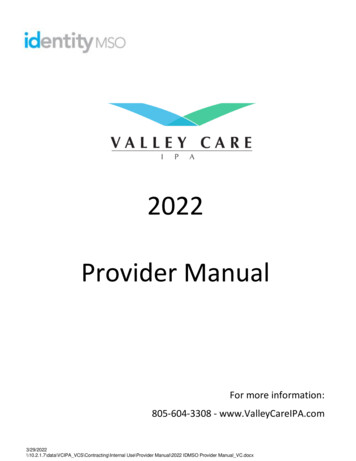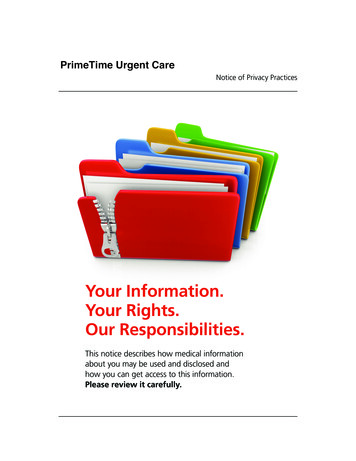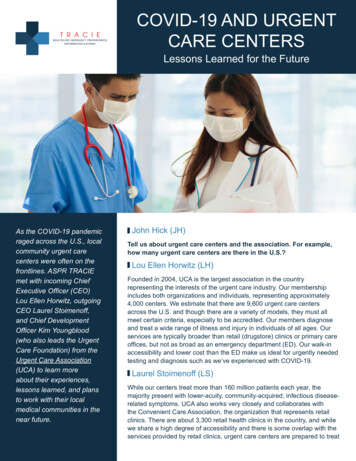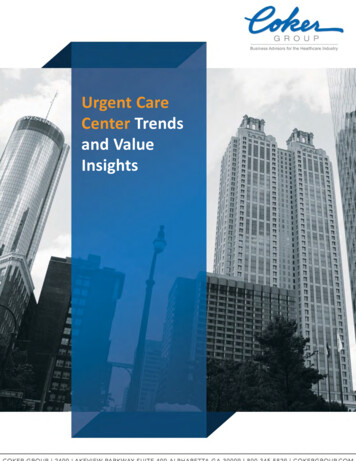
Transcription
Urgent Care PathwayImprovement ProgrammeDan HollidaySenior Operations ManagerChris JacksonUrgent Care Pathway Manager
Purpose of this PaperThis document, which sits alongside SCAS Joint Strategic Plans, has been prepared toinvestigate ways that we can improve urgent care pathways for the NHS Five Year Forward View7 Pillars.It features tailored recommendations for developing an integrated approach to working with ourcommissioning partners across our network. We have highlighted and benchmarked againstgood practice, suggesting opportunities for development to enable people to access the rightcare, first time to improve patient outcomes.OverviewNHS 5 Year Forward ViewIn 2017, NHS England announced the next steps for the NHS Five Year Forward View. Thisincludes key deliverables for Urgent and Emergency Care, summarised in 7 Pillars. For the‘Ambulance Pillar’, local care systems need to “offer an integrated model of care, with clearreferral pathways offering alternatives to conveyance to A&E by March 2018”.The Commissioning for Quality and Innovation (CQUIN)The CQUIN scheme is intended to deliver clinical quality improvements and drivetransformational change. With these objectives in mind the scheme is designed to support theambitions of the Five Year Forward View and directly link to the NHS Mandate.URGENT CARE PATHWAY IMPROVEMENT PROGRAMME PLANDAN HOLLIDAY / CHRIS JACKSON1
URGENT CARE PATHWAY IMPROVEMENT PROGRAMME PLANDAN HOLLIDAY / CHRIS JACKSON2
Operational Productivity and Performance in English NHS Ambulance TrustsA review of Ambulance Services productivity and performance was published by Lord Carter inSeptember 2018. It reported that 10 million calls were answered with 7 million responses whichshows an average annual increase in demand of 6%. 9 out of 10 of these calls were not life threatening60% of the patients attended were taken to hospital40% of patients in hospital beds are conveyed by ambulanceTackling avoidable conveyance to hospital could release capacity equivalent to 300m inthe acute sectorAs well as response times, job cycle time and ambulance handover delays, SCAS is shown asperforming well across the board compared to other Ambulance Trusts by having one of thelowest rates for see and convey to the Emergency Department.It recommended several areas where improvement is required by Ambulance Services. Ability to access general practice and Community Services to avoid unnecessaryconveyanceAccess to a Directory of Services, pathways and patient informationAmbulance Staff need greater clinical and managerial support to ensure they feelconfident treating patients over the phone or in their homeDeveloping the digital ambulance by rapid adoption of new technologies.Variations in Ambulance Non-Conveyance Study (VANS)The National Institute for Health Research (NIHR) has funded a study to understand why rates ofnon-conveyance vary between ambulance services and between different localities in ambulanceservices. The focus is on three types of non-conveyance:- Provision of telephone advice and signposting rather than dispatching a vehicle (‘hear andtreat’)- Treatment at the scene (‘see and treat’) and- Transport to facilities other than an emergency department such as an urgent care centreor walk in centre (‘see and convey elsewhere’).URGENT CARE PATHWAY IMPROVEMENT PROGRAMME PLANDAN HOLLIDAY / CHRIS JACKSON3
As acuity increases it is expected that more patients will need to go to the EmergencyDepartment unless new pathways are established for Ambulance Clinicians to use.To achieve this, there has been a review of the current alternative care pathway options for SouthCentral Ambulance Service Clinicians across our entire network.We have identified the good practice that is available and working well in each area. We havecompared and analysed the non-conveyance options versus the pathway availability and access.Using this information we have been able to identify where there are shortfalls and suggest wherepotential improvements can be made. Each area will be offered a bespoke package ofsuggested options based on their existing pathways and the benchmarking of good practiceoffered by our services and our partners.ContentsPurpose & OverviewPage -1-What we have nowPage -5-What SCAS does wellPage -6-Where we could improve - Key RecommendationsPage -7-Core Pathway SetPage -8-Hospital Clinical NavigatorPage -9-SCAS Urgent Care Clinical NavigatorPage -10-SCAS Mobile Urgent Care TeamPage -11-Clinical Co-ordination Centres & Integrated Urgent Care HubPage -12-Relative Effort Vs Potential WinsPage -13-Digital Support PlatformPage -14-Key ConsiderationsPage -16-ChallengesPage -17-Work StreamsPage -20-Summary of RecommendationsPage -22-AppendicesPage -24-GlossaryPage -25-AbbreviationsPage -26-URGENT CARE PATHWAY IMPROVEMENT PROGRAMME PLANDAN HOLLIDAY / CHRIS JACKSON4
What we have now There is currently a wide array of options available to our mobile clinicians and 111 partnerswhen it comes to deciding an appropriate care pathway for our patients. As well as theemergency transportation to ED, pPCI, HASU, Trauma Units and Vascular Units it cansometimes be confusing for them to select the right care first time.111Urgent Care CentreIntermediate CareMental HealthSpecialistPractitionerCare HomeSupportOthersFalls PreventionUrgent CareDiabetic/HypoglycaemiaOut ofHours GPDistrict NursesCommunity MatronSexual HealthEye CasualtyMaternity/Early PregnancyCancer/HaematologyPalliative CareBladder/Bowel ServiceDrug/Alcohol ServiceCOPD/RespiratoryCCF CareGP PracticeMS/ParkinsonsHospital ReferralURGENT CARE PATHWAY IMPROVEMENT PROGRAMME PLANDAN HOLLIDAY / CHRIS JACKSON5
What SCAS does well Together with our partners, we have worked hard across the SCAS network to provide someexcellent programmes to deliver the best possible service to our users.- National Ambulance Response Programme (ARP)- Alternative transport options for Mobile Clinicians -PTS/Taxis- Interface Medical Team for Oxford UniversityHospitals- Integrated Urgent Care Model for Thames Valley- Live Links (Skype)- Midwives & Mental Health Advisors in CCC- 111 Link to Wokingham Hub- 24/7 Adult Mental Health Advice & Referrals in Oxfordshire- Maternity, Obstetrics and Gynaecology Referrals in Oxfordshire- 24/7 Cancer & Haematology Referrals in Oxfordshire- Urgent Care Specialist Paramedic Practitioner Programme- Waterlooville Vanguard Project- Falls & Frailty Response Project- Specialist Paramedic Practitioner Collaboration Programme- Chipping Norton First Aid Unit- Reading Minster Project- Direct Medical & Surgical Referrals - MKUH/JRH/SMH- Links with Nursing & Residential Home Community Teams- Intermediate Care Teams - MK/AV/Berkshire - Some with 24/7 access- North Hampshire GP Early Bird- Safe Space City Centre MIU- ICE Bus in Southampton City Centre- Demand PractitionersURGENT CARE PATHWAY IMPROVEMENT PROGRAMME PLANDAN HOLLIDAY / CHRIS JACKSON6
Where we could improve - Key RecomendationsCore Urgent Care Pathway SetAcross the SCAS network, we have talked with our clinicians about the Urgent Care Pathwaysthat are available and what they believe should be available to benefit our patients. We have alsoreviewed our nature of call categories and the final disposition of the patient, which has enabledus to identify specific conditions where a more appropriate urgent care pathways could offer ‘rightcare, first time’ if they were available.Urgent low acuity medically unwell patientsOlder patients who are frail, have chronic medical conditions or who are at risk of fallsPeople with Chronic and Acute Respiratory Conditions, including COPD and AsthmaPatients requiring urgent surgical assessmentPeople with Mental Health needs or who have suffered Deliberate Self HarmPaediatric patients who require a review in an UCC by a GP or in a Hospital by thePaediatric Assessment Team.By targeting these groups, and directing them to the most appropriate care pathway to theirneeds, we believe this would have a significant effect to delivering better care to these patients.We would like to suggest to each local care system a model that has a core set of integratedurgent care pathways that could be mirrored across the SCAS footprint.URGENT CARE PATHWAY IMPROVEMENT PROGRAMME PLANDAN HOLLIDAY / CHRIS JACKSON7
Hospital Referral Ability for SCAS clinicians to refer patients directly to a medical or surgicalassessment unit to avoid Emergency Department front door This pathway should be available for both Adult and Paediatric referrals Direct access & referral to an acute frailty service so a clinical frailtyassessment can be completed in line with the Same Day Emergency CaremodelRespiratory Pathway There is a high volume of calls across the SCAS Network to patients withbreathlessness or wheeze This may be the elderly with a Long Term Condition or a child with Asthma.They all represent a relatively high proportion of patients that attend ED andan opportunity exists to make significant improvements with these cohortsIntegrated Intermediate Care - Single Point of Access One team to access . Fraility support for vulnerable adults who are unwell, have chronic medicalconditions that can be managed at home or who have fallen to avoidunplanned hospital admissions Re-enablement at home after hospital discharge to avoid re-admissionNursing Home Support Team There is a large call volume across SCAS footprint from these facilities Dedicated Nursing Team to reduce unnecessary Emergency Departmentattendance and unplanned hospital admissionsMental Health Provision Ability to be able to access support/advice or refer patients who are havinga Mental Health Crisis directly to a Professional Mental Health ProviderPaediatric Referrals Paediatric patients represent a large percentage of patients who attend theEmergency Department Those that are not acutely unwell enough to require immedicate treatmentin the ED may be more appropriately reviewed in an UCC by a GP orSpecialist Nurse or in a Hospital by the Paediatric Assessment TeamURGENT CARE PATHWAY IMPROVEMENT PROGRAMME PLANDAN HOLLIDAY / CHRIS JACKSON8
Hospital Clinical NavigatorSome patients that SCAS transport to hospital are conveyed inappropriately to ED and could beadmitted directly to a different location within the hospital. We are recommending that eachAcute Hospital Trust establishes a Clinical Navigator so that our clinicians can discuss the correctpathway to suit a patient’s needs.SCAS Clinician attends 999/111 callClinical decision made to Convey to HospitalClinician calls Hospital ‘Clinical Navigator’Clinician Signposted by Hospital ‘Clinical Navigator’ to .EDMedicalReferralSurgicalReferralURGENT CARE PATHWAY IMPROVEMENT PROGRAMME PLANDAN HOLLIDAY / CHRIS JACKSONPaediatricReferralCommunityServices9
SCAS Urgent Care Clinical NavigatorWhen a patient doesn’t need to be transported to hospital there are a considerable amount ofUrgent Care Pathway options available for our mobile clinicians. Coupled with this, there arecomplexities of working in unfamiliar locations with access to unfamiliar pathways. The GPTriage Scheme available to our clinicians can be limited at times due the capacity and workloadof the GPs. To assist our clinicians we believe a potential opportunity exists for the developmentof an Urgent Care Clinical Navigator role. This could sit within our Specialist Practitioner Hub orthe Intergrated Urgent Care Hub, depending on the approach agreed with partners in the localsystem.SCAS Clinician attends 999/111 callClinical decision made to Non-Convey and refer to an Urgent Care PathwayClinician calls SCAS ‘Urgent Care Clinical Navigator’(SP HubIUC Hub)Clinician Signposted by SCAS ‘Urgent Care Pathway Navigator’ to .IntermediateCareUrgent talHealthGP PracticeURGENT CARE PATHWAY IMPROVEMENT PROGRAMME PLANDAN HOLLIDAY / CHRIS JACKSONOOH GP111Care HomeSupportOtherCommunityPathwayHospitalReferral10
SCAS Mobile Urgent Care TeamUpholding the philosophy of learning from good practice, we believe a dedicated Urgent CareTeam should be established which draws on the successes of the Falls and Frailty ResponseProject. This team would be created within the proposed Urgent and Emergency Care tier as partof the Operational Rostering Transformation Programme development. The deployment modelwould utilise the existing Ambulance Technician, Associated Ambulance Practitioners andEmergency Care Assistant cohorts working alongside the Urgent Care Specialist ParamedicPractitioners. As a dedicated team they will be able to respond to the low acuity category 3 and 4calls across the SCAS network to provide a trusted and consistent approach with establishedlinks to our local care systems.Consideration of the development and estyablishment of this role could be considered in thefuture steps of the Urgent Care ApproachOtherMobileUrgentCare TeamEstablishedPathwaysLinkURGENT CARE PATHWAY IMPROVEMENT PROGRAMME PLANDAN HOLLIDAY / CHRIS JACKSONHCP / ECATrustedClinicalAssessor11
Clinical Co-ordination Centres (CCC) and Integrated Urgent Care (IUC) HubWhere there has been some good work in one area and it has been proved to work well, thisshould be mirrored so that it is available to staff across our network. Examples of this arehighlighted by the Mental Health and Maternity support line availability in our CCCs. We shouldlook to further develop our links with the Integrated Urgent Care Hub to improve the access tothese resources for our clinicians and patients.North CCCSouth CCC Expand the hours of MentalHealth Support lineavailability to Clinical Staff Expand the hours ofMaternity Advisor Supportline availability to ClinicalStaff Introduce the MaternityAdvisor Support lineavailability to Clinical Staffto align with South CCCURGENT CARE PATHWAY IMPROVEMENT PROGRAMME PLANDAN HOLLIDAY / CHRIS JACKSON Introduce the MentalHealth Support lineavailability to Clinical Staffto align with North CCC12
Relative Effort vs Potential WinsWe recognise that developing and establishing new pathways can be challenging. We willsuggest to each area the development of pathways where we feel that our partners and SCAScan gain the most benefit for the largest number of patients with the least amount of effort.Significant Effort - Greater ImpactMinimal Effort - Greater Impact- Integrated Intermediate Care / Falls &Frailty / Admission Avoidance - SPA- Hospital Medical/Surgical ReferralsSmaller ImpactGreater Impact- Nursing/Care Home Support Team- Hospital Paediatric Referrals- UCC Paediatric Referrals- Review Specialist Paramedicdeployment model within the ARP totarget high conveyance groups - e.g.Respiratory / Frail Older persons /Urgent medical conditions- Mental Health Direct Referrals/Advice Line- Community/Hospital RespiratoryPathwaysSignificant Effort - Smaller ImpactMinimal Effort - Smaller Impact- Community Diabetic Nurse Referrals- Palliative Care Direct Referrals/Advice Line- Early Pregnancy/Maternity, Obstetric& Gynaecology Assessment Unitsavailable for referral by 999 StaffGreater EffortURGENT CARE PATHWAY IMPROVEMENT PROGRAMME PLANDAN HOLLIDAY / CHRIS JACKSON- Drug/Alcohol Support Referral- Cancer/Haematology ServiceLesser Effort13
Digital Support PlatformSCAS has mobile clinicians dispersed across its geography on a 24/7 basis. This places SCAS ina unique and pivotal position, as local care systems are searching to offer a variety of carepathways to both facilitate patients being looked after in their own home or their transport to anappropriate healthcare facility for ongoing care.Consistently Clinicians are mobilised to various areas throughout SCAS localities during anygiven shift to respond to calls generated via 999 or 111.SCAS workforce planning also regularly requires SCAS Clinicians to work from various ResourceCentres across different Operational Nodes and CCG Borders depending on shortfalls inprovision.CCGs provide a wide range of different services across the entire SCAS geographical network.Often these services may provide the same basic function, with a similar acceptance criteria, butwill have a different name along with different access times. These inconsistencies cause furtherconfusion and uncertainty about the potential for referring patients to that service.CCG borders cross SCAS Operational Node borders and various points throughout thegeographical areas resulting in dynamic changes to the pathways that are available to SCASclinicians during their shift.The Pathways DoS exists with contact details that are generic to all Healthcare Professionals.There is no specific information within the DoS surrounding the referral guides, acceptancecriteria or SCAS specific telephone contact numbers for each available pathway within SCASlocalities.URGENT CARE PATHWAY IMPROVEMENT PROGRAMME PLANDAN HOLLIDAY / CHRIS JACKSON14
We would like to utilise ‘MiDoS’, which is an established digital support software solution that willhelp deliver improved patient care, SCAS clinical strategy and vision, improved cycle time,consistency and future sustainability. The application, available on smart phones, ePR Units anddesktop computers, will be able to provide all our clinicians whether they are mobile in thecommunity or based in our CCC, with the referral information to all Urgent Care Pathways acrossour network within all our local care systems.There are significant benefits to the proposed solution, including:-Improved access to live data including the DoS which is automatically updated dailyProven system which is used by several other Ambulance NHS TrustsQuick procurement to start-up time to begin realising benefitsSupports demonstration of achievement of CQUIN TargetsSome of our system partners are engaged and considering utilising the same system.Costs can be shared with CCG partnersAccessible solution to all staff on various platforms - Smart Phones, ePRs, ComputersystemsCaptures search and referral information to allow for rich data management for reporting andanalysisUnlimited device accessAble to locate the user and search for services based on localitySearch and referral functions embeddedAbility to feedback gaps in service to SCAS and commissioning partnersImproved Non-Conveyance, Patient Care and Patient ExperienceSignificant opportunities to further develop this as a bespoke system for multi-function usesImproved Hear & Treat as CSD will be able to access systemImproved See & Treat by mobile cliniciansReduced hospital queuingLive system capacity status if service providers utilise the system and update dataURGENT CARE PATHWAY IMPROVEMENT PROGRAMME PLANDAN HOLLIDAY / CHRIS JACKSON15
Key Considerations 1. Other key Urgent Care Pathways Services to avoid acute admissions through ED tobenefit patient care and experienceDiabetic/HypoglycaemiaDrug and Alcohol Referral and AdviceEnd of Life/Palliative Care SupportMaternity/Early Pregnancy AssessmentBladder & Bowel Continence ServicesCancer/Haematology Services2. Brand & Launch SCAS Urgent Care PathwaysWe should aim to re-balance the current disparity between the Emergency and Urgent Carefocus. Instead it should be realigned to better reflect the call volume, pathway options availableto clinicians and the SCAS Emergency and Urgent Care Directorate.The term ‘Alternative Care Pathway’ should become a thing of the past. This phrase hashistorically been used as a default option when the main disposition was for clinicians to take apatient to the Accident & Emergency Department. Today’s Ambulance Service has a pivotalrole in local care systems to deliver the right care, first time. Our focus should be on ensuringthe appropriate care should be provided for every patient we see. If the patient doesn’t requireconveyance to hospital the available pathways shouldn’t be seen as an alternative, but seen asthe most suitable ‘Urgent Care Pathway’It is important for Urgent Care to be visible and have a consistent identity. To support the focuson Urgent Care Delivery and to reinforce the phrase ‘Urgent Care Pathways’, a logo hasdeveloped a logo visual, brand and ‘Mission Statement’ to be used with all SCASdocumentation associated with Urgent Care delivery.Mission Statement“SCAS will deliver an integrated and streamlined approach across our network toimprove patient outcomes.By working with our local care system partners, we will ensure our patients access themost appropriate care according to their needs, first time, every time.”URGENT CARE PATHWAY IMPROVEMENT PROGRAMME PLANDAN HOLLIDAY / CHRIS JACKSON16
Logo & Header Visuals3. Business IntelligenceImproved analysis should be readily accessible and visible on Hear & Treat (H&T), See & Treat(S&T), See Treat & Convey to Emergency Department (ST&C ED) and See Treat & Convey toNon-Emergency Department (ST&C Non-ED) for each local care system. By doing this ouroperational and clinical teams can work with partners to identify scope for improvement andmeasure the impact of any changes made.4. Staff Development, Education & TrainingA rollout of the Urgent Care Pathway Programme to deliver the concepts and plans for futuredevelopment has been prepared. It includes:- Presentations to Executives and Senior Leadership Teams- Core Service groups e.g. Clinical Review Group/Patient Safety Group- Operational Managers at all levels- Support Service Teams e.g. Communcations, HR, Recruitment, CCC, Finance, Education,SCAS Charity. etc- Specialist Practitioner Teams- Operational Team TrainingOther key publicity itemsfor the rollout programme include posters, flyers, mugs, stickers, pocketcards, Intranet publications, regular ‘Staff Matters’ articles, SCAS internet page, development ofsocial media, access to header and logo visuals for all staff.The rollout of any new pathways should be delivered locally with a centrally agreed plan so anyunderpinning understanding can be managed by local Team Leaders. This process is still to bedeveloped.Investment in Staff Development with an Education and Training Package should be consideredto reflect the focus on Urgent Care Pathways. Clinical staff should be backed by SeniorClinicians and Managers with an organisational commitment to actively support the discharge ofpatients at scene or use of Urgent Care Pathways. An important part of this would be allowingclinicians time at scene to do this and receiving feedback on their clinical results.URGENT CARE PATHWAY IMPROVEMENT PROGRAMME PLANDAN HOLLIDAY / CHRIS JACKSON17
5. New ResearchThe National Institute for Health Research (NIHR) has funded a Variations in Ambulance NonConveyance Study (VANS) to understand why rates of non-conveyance vary betweenambulance services are between different localities in ambulance services. The focus is onthree types of non-conveyance:- Provision of telephone advice and signposting rather than dispatching a vehicle (‘hear andtreat’)- Treatment at the scene (‘see and treat’) and- Transport to facilities other than an emergency department such as an urgent care centreor walk in centre (‘see and convey elsewhere’).Key learning points- The higher the education level of the clinician the more non-conveyance.- Risk averse Ambulance Services had higher conveyance.- Ambulance Services with high motivation to undertake non-conveyance had higher nonconveyance.- Pressure on community services increased demand on ambulance services and limited theability to discharge at scene.- Differences in different service availability in different CCGs and Ambulance staffknowledge of the services affected the ability to discharge at scene.- Initiatives that increased staff confidence that other sevices will take over care followingnon-conveyance could in
Urgent Care Pathway options available for our mobile clinicians. Coupled with this, there are complexities of working in unfamiliar locations with access to unfamiliar pathways. The GP Triage Scheme available to our clinicians can be limited at times due the capacity and workload of the GPs. To assist our clinicians we believe a potential .



